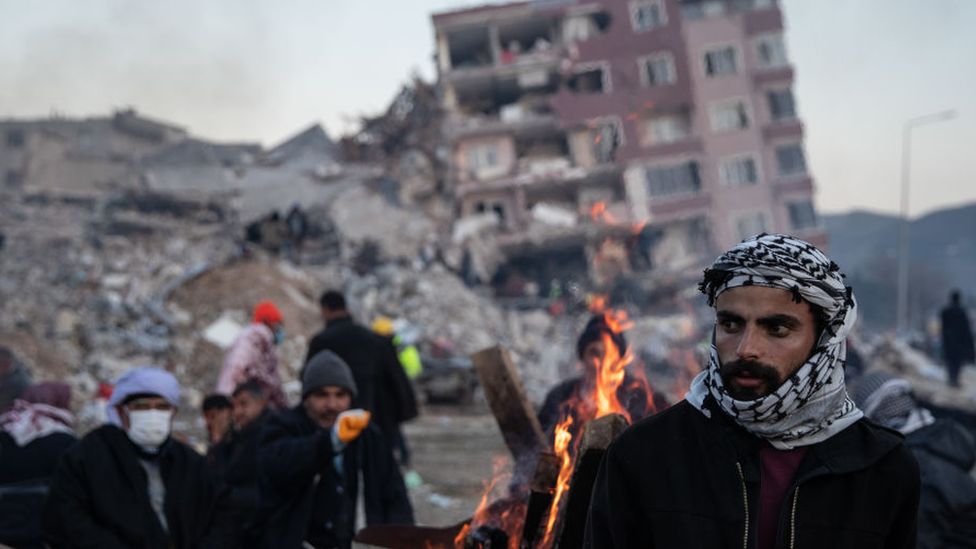The Agony and the Sorrow
"The first 72 hours are considered to be critical.""The survival ratio on average within 24 hours is 74 percent; after 72 hours it is 22 percent; and by the fifth day it is six percent."Steven Godby, natural hazards expert, Nottingham Trent University, England"As of today, there is no hope left in Malatya.""No one is coming out alive from the rubble."Ozel Pikal, journalist
 |
| More than 20,000 people are
now known to have been killed in Monday's earthquakes in Turkey and
Syria, though the UN warns the disaster's full extent is still unclear. Getty Images |
The widespread scale of the catastrophe caused by the powerful earthquake that struck Turkey and Syria on Monday led to desperate measures in the hopes of rescuing an untold number of victims trapped in the rubble of thousands of destroyed buildings. The very widespread ground area of devastation meant that rescue teams would never be able to cover the entire area in a timely manner; the time-consuming, careful work involved in a single site, extracting survivors and pulling out dead bodies mitigates against swiftly leaving one site and moving on to another.
Most rural areas were left of necessity to their own resources, leaving people to try with their bare hands to move rubble and respond to the waning voices of the trapped begging for rescue. The more isolated the town, the more devastatingly shocking the trauma in the realization that there would be no speedy rescues. The work involved in identifying victims and burying them is monumental in nature, reflecting the scope of the misery and horror.
The first, most destructive magnitude7.8 quake, shallow in depth, followed by a cascade of aftershocks including one of 7.5 magnitude in strength, almost equal to the original, brought down more buildings, left more victims; tens of thousands of injuries and an entirely traumatized generation of survivors. The destruction stretched hundreds of kilometres across southeastern Turkey and neighbouring Syria where thousands of buildings were toppled.
 |
| Rescuers carry Zeynep Polat, who was pulled from a collapsed building in Kahramanmaras in southern Turkey on Thursday. Thinly stretched rescue teams continue their around-the-clock work to try to find any survivors or recover bodies from the rubble in Turkey and Syria. (Ismail Coskun/IHA/The Associated Press) |
Hatay province in Turkey was among the hardest hit with entire neighbourhoods destroyed and where residents criticized the government's slow response. The earthquake had destroyed Hatay's airport runway disrupting the response of rescuers. From over two dozen countries search and rescue teams joined with tens of thousands of local emergency personnel in both countries. Experts warn the survival window for the trapped under rubble, along with survivors in desperate need of necessities was closing rapidly.
Excavators were used by rescue teams at times, and alternately the debris was tackled delicately where there was cause to believe people were trapped close to the surface of the rubble. The sheer numbers of those trapped is impossible to imagine given the number of buildings toppled. The plan is to photograph unidentified bodies and to bury them within five days once DNA tests and finger-printing was completed.
The toll of the dead is inexorably rising, and has now eclipsed an earlier earthquake that took 19,000 lives decades earlier. The cold of winter, destroyed roads, a lack of supplies, hamper the work of the estimated 100,000 rescue workers and threaten survival of the now-homeless. The news of 20,000 dead being surpassed and concerns over the final number lend a sense of hopelessness to the ongoing search for survivors. Those who survived and are homeless sleep wherever they can; food, water, medical supplies and shelter slowly trickling in.
 |
| Hundreds of thousands of people are homeless after Monday's quake hit Turkey and Syria. Here, people warm around a fire as rescuers continue their work on Thursday night in Kahramanmaras, Turkey. (Petros Giannakouris/The Associated Press) |
Labels: Death Toll, Earthquake, Natural Disaster, Search and Rescue, Syria, Turkey
0 Comments:
Post a Comment
<< Home